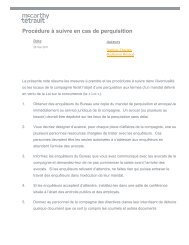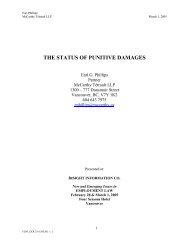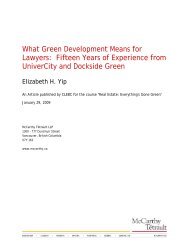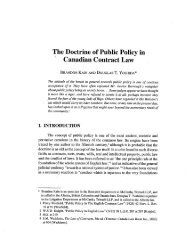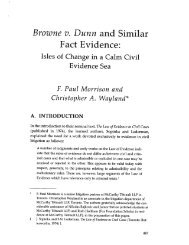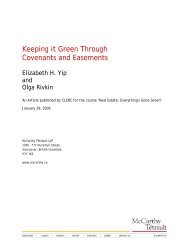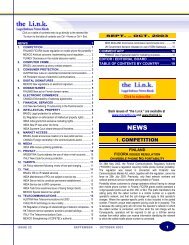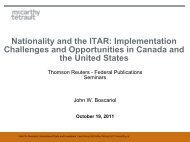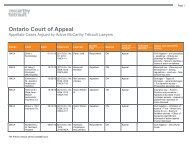Presentation Material - McCarthy Tétrault
Presentation Material - McCarthy Tétrault
Presentation Material - McCarthy Tétrault
Create successful ePaper yourself
Turn your PDF publications into a flip-book with our unique Google optimized e-Paper software.
Chris Falk<br />
Stefanie Morand<br />
<strong>McCarthy</strong> Tétrault LLP<br />
Statutory Interpretation<br />
The principles governing the interpretation of tax statutes have been considered in a number of<br />
decisions of the Supreme Court of Canada. 62 In Canada Trustco, the Court summarized the<br />
approach to statutory interpretation as follows (at paragraph 10):<br />
It has been long established as a matter of statutory interpretation that “the words of an Act are<br />
to be read in their entire context and in their grammatical and ordinary sense harmoniously with<br />
the scheme of the Act, the object of the Act, and the intention of Parliament”: see 65302 British<br />
Columbia Ltd. v. Canada, 1999 CanLII 639 (S.C.C.), [1999] 3 S.C.R. 804, at para. 50. The<br />
interpretation of a statutory provision must be made according to a textual, contextual and<br />
purposive analysis to find a meaning that is harmonious with the Act as a whole. When the<br />
words of a provision are precise and unequivocal, the ordinary meaning of the words play a<br />
dominant role in the interpretive process. On the other hand, where the words can support<br />
more than one reasonable meaning, the ordinary meaning of the words plays a lesser role. The<br />
relative effects of ordinary meaning, context and purpose on the interpretive process may vary,<br />
but in all cases the court must seek to read the provisions of an Act as a harmonious whole.<br />
(emphasis added.)<br />
The Court added the caution that “[e]ven where the meaning of particular provisions may not<br />
appear to be ambiguous at first glance, statutory context and purpose may reveal or resolve<br />
latent ambiguities”. 63<br />
More recently, in Placer Dome, 64 the Supreme Court of Canada affirmed the statements in<br />
Canada Trustco and provided the following guidance regarding the appropriate role of legislative<br />
purpose in statutory interpretation (at paragraphs 22 and 23):<br />
[W]here the words of a statute give rise to more than one reasonable interpretation, the ordinary<br />
meaning of words will play a lesser role, and greater recourse to the context and purpose of the<br />
Act may be necessary: Canada Trustco, at para. 10. Moreover, as McLachlin C.J. noted at<br />
para. 47, “[e]ven where the meaning of particular provisions may not appear to be ambiguous at<br />
first glance, statutory context and purpose may reveal or resolve latent ambiguities.” The Chief<br />
Justice went on to explain that in order to resolve explicit and latent ambiguities in taxation<br />
legislation, “the courts must undertake a unified textual, contextual and purposive approach to<br />
statutory interpretation”.<br />
The interpretive approach is thus informed by the level of precision and clarity with which a<br />
taxing provision is drafted. Where such a provision admits of no ambiguity in its meaning or in<br />
its application to the facts, it must simply be applied. Reference to purpose of the provision<br />
“cannot be used to create an unexpressed exception to clear language” […] Where, as in this<br />
case, the provision admits of more than one reasonable interpretation, greater emphasis must<br />
be placed on the context, scheme and purpose of the Act. Thus, legislative purpose may not be<br />
used to supplant clear statutory language, but to arrive at the most plausible interpretation of an<br />
ambiguous statutory provision. (emphasis added)<br />
The meaning of the text of subsection 40(3.61), even without regard to context and purpose, is<br />
uncertain. Subsection 40(3.61) clearly contemplates that subsection 164(6) applies before<br />
62<br />
63<br />
64<br />
See, for example, Antosko v. The Queen, 94 DTC 6314 (SCC); Canada Trustco, supra, note 28; and Placer<br />
Dome, infra, note 64.<br />
Supra, note 28, at para. 47.<br />
Placer Dome Canada Ltd. v. Ontario (Minister of Finance), 2006 DTC 6532 (SCC).<br />
560600/422632<br />
MT DOCS 11864055v1G<br />
23



